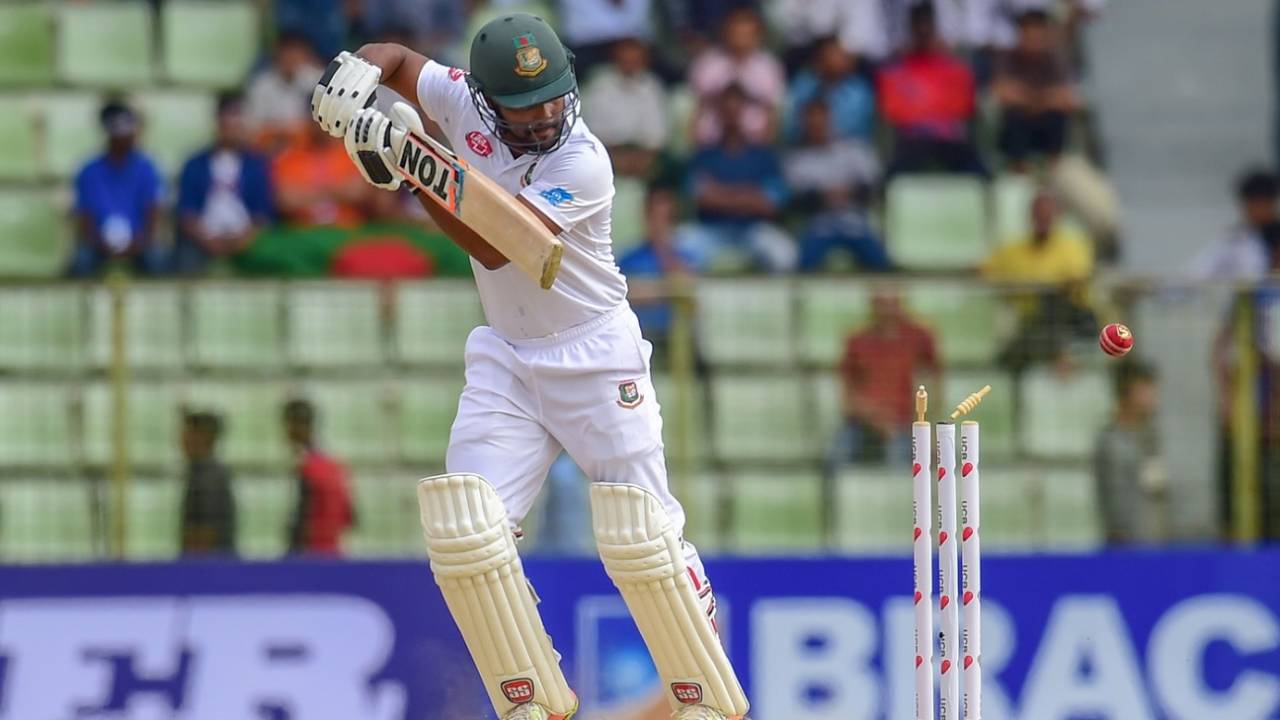Soaring in ODIs, Bangladesh's batting plummets to new Test-match low
Possibly still stuck in one-day mode, Bangladesh failed to reach 200 for the seventh successive Test innings
Mohammad Isam in Sylhet
04-Nov-2018
Imrul Kayes was bowled off an inside edge • AFP
Shakib Al Hasan and Tamim Iqbal were missing in Sylhet. This was Bangladesh's first home Test in eight months. They have come into the game on the back of 12 ODIs since August. Zimbabwe won the toss.
The explanations and excuses, however, have to stop right there. Zimbabwe bowled Bangladesh out for 143. It was the seventh successive Test innings in which they didn't get to 200.
This has come at a time when Bangladesh have won eight of their last 12 ODIs, beating West Indies 2-1 at home, reaching the Asia Cup final, and crushing Zimbabwe 3-0. The batsmen have made seven centuries and the bowlers have contributed in every win.
The contrast couldn't be starker in Tests. Sri Lanka and West Indies crushed them, and now Zimbabwe have a 140-run lead going into the third day in Sylhet, with all ten wickets in hand. Bangladesh might well need a miracle to win or draw this game. A turnaround, like Bangladesh's to save a Test against Pakistan in Khulna in 2015, cannot yet be ruled out. But given how woeful the first-innings batting was, and how lopsided the bowling attack is, such a turnaround seems fanciful.
Imrul Kayes and Mahmudullah were bowled off inside edges, against deliveries they could have left alone. Liton Das, Mushfiqur Rahim, Nazmul Hossain Shanto and Mominul Haque were out playing at away-going deliveries. The dismissals of Liton and Mushfiqur followed boundaries struck through the off-side. Reading too much into Ariful Haque's unbeaten 41 on debut would be premature, particularly because he came in after the initial spells of Tendai Chatara and Kyle Jarvis.
Perhaps Mehidy Hasan Miraz could have contributed a little more at No 8, but when a side has picked seven full batsmen, it is extremely difficult to point fingers at the bottom four.
Chatara, Jarvis and Sikandar Raza underscored Bangladesh's haplessness in front of disciplined bowling, and it should be particularly chastening since it happened on a relatively good pitch to bat on. Raza, Brandon Mavuta and Sean Williams were not spitting venom like Rangana Herath and Akila Dananjaya did in Dhaka back in February. Nor were Chatara and Jarvis bowling in Antigua or Kingston. They were simply testing the batsmen's patience. The test lasted just 51 overs.
In these last seven innings in Test cricket, Bangladesh have managed an average total of 126 while lasting an average of 39 overs. Among the four batsmen who have batted in all seven innings, Mushfiqur has the highest balls-faced-per-innings figure, a meagre 33. Liton has faced 31 balls per innings while Mominul and Mahmudullah have faced 20 and 14 on an average, respectively.
It's not as if these batsmen have been in poor form across formats. In the same period, Mushfiqur has averaged 55.00 in ODIs, and Imrul 86.40, with two hundreds. Liton has scored 120 in the Asia Cup final and 83 in the second ODI against Zimbabwe. Batting down the order, Mahmudullah has played some important innings too.
Why then have all of them struggled so much in Test cricket of late? One common thread running through the top seven in the first innings in Sylhet was of batsmen repeatedly playing away from their body. Chatara suggested they might have still been in one-day mode, which helped his discipline pay off.
Bangladesh's Test batting gained a decent amount of confidence over the tours of New Zealand, India and Sri Lanka in 2017. Since then, though, starting with the home series against Australia and particularly after a disastrous tour of South Africa, those gains have evaporated.
This inconsistency has a lot to do with the type of pitches used at home. Dhaka's dark clay doesn't encourage longer-version batting, while Chittagong is a featherbed. Sylhet is a typical sub-continent pitch that is expected to take turn from the third day. Batting in South Africa and West Indies has been difficult, but the same batsmen have done better in ODIs and T20Is.
The question of context, once again, rears its ugly head. How much does this series, against Zimbabwe, mean? With an ODI World Cup coming up in seven months, do Bangladesh care for Test cricket? If they do, the second innings in Sylhet is a good place for them to start showing it.
Mohammad Isam is ESPNcricinfo's Bangladesh correspondent. @isam84
